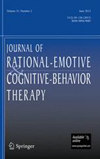
The Journal of Rational-Emotive and Cognitive Behavior Therapy is an international journal that publishes scholarly original papers concerning Rational Emotive Behavior Therapy (REBT), Cognitive Behavior Therapy (CBT), behavior therapy, cognitive-behavioral hypnosis, and hypnotherapy, clinical and counseling psychology, psychiatry, mental health counseling, and allied areas of science and practice. The journal encourages scholarly debate amongst professionals involved in practice, theory, research, and training in all areas of scholarship relevant to REBT and CBT. The Journal is particularly interested in articles that define clinical practice and research and theoretical articles that have direct clinical applications. The Journal seeks theoretical discussions and literature reviews on the cognitive bases of the development and alleviation of emotional, behavioral, interpersonal, personality, and addictive disorders. We consider submissions on the applications of REBT and CBT to new areas of practice and client populations. The Journal considers the term Cognitive Behavior Therapy to represent a generic, overriding category or school of psychotherapy approaches that includes many different theories and techniques. The journals encourages research that clearly identifies the specific hypothetical constructs and techniques being measured, tested, and discussed, and the comparison of the relative influence of different cognitive processes, constructs, and techniques on emotional and behavioral disturbance. The Journal provides a timely introduction to unexplored avenues on the cutting edge of REBT and CBT research, theory, and practice.The Journal publishes:discussions of the philosophical foundations of psychotherapiestheory-buildingtheoretical articlesoriginal outcome research articlesbrief research reportsoriginal research on the support of theoretical models development of scales to assess cognitive and affective constructsresearch reviewsclinical practice reviewsempirically-based case studiesdescriptions of innovative therapeutic techniques and proceduresadvances in clinical trainingliterature reviews book reviewsUnder the guidance of an expanded, international editorial board consisting of acknowledged leaders in the field, the journal disseminates current, valuable information to researchers and practitioners in psychology, psychotherapy, psychiatry, mental health counseling, social work, education, and related fields.
《Journal Of Rational-emotive And Cognitive-behavior Therapy》是一本由Springer Nature出版商出版的专业心理学期刊,该刊创刊于1983年,刊期4 issues per year,该刊已被国际权威数据库SCIE、SSCI收录。在中科院最新升级版分区表中,该刊分区信息为大类学科:心理学4区,小类学科:心理学:临床 4区;在JCR(Journal Citation Reports)分区等级为Q3。该刊发文范围涵盖PSYCHOLOGY, CLINICAL等领域,旨在及时、准确、全面地报道国内外PSYCHOLOGY, CLINICAL工作者在该领域取得的最新研究成果、工作进展及学术动态、技术革新等,促进学术交流,鼓励学术创新。2023年影响因子为1.7,平均审稿速度 。
中科院分区(当前数据版本:2023年12月升级版)
| 大类学科 | 分区 | 小类学科 | 分区 | Top期刊 | 综述期刊 |
| 心理学 | 4区 | PSYCHOLOGY, CLINICAL 心理学:临床 | 4区 | 否 | 否 |
中科院分区(当前数据版本:2022年12月升级版)
| 大类学科 | 分区 | 小类学科 | 分区 | Top期刊 | 综述期刊 |
| 心理学 | 4区 | PSYCHOLOGY, CLINICAL 心理学:临床 | 4区 | 否 | 否 |
中科院分区(当前数据版本:2021年12月旧的升级版)
| 大类学科 | 分区 | 小类学科 | 分区 | Top期刊 | 综述期刊 |
| 心理学 | 4区 | PSYCHOLOGY, CLINICAL 心理学:临床 | 4区 | 否 | 否 |
中科院分区(当前数据版本:2021年12月升级版)
| 大类学科 | 分区 | 小类学科 | 分区 | Top期刊 | 综述期刊 |
| 心理学 | 4区 | PSYCHOLOGY, CLINICAL 心理学:临床 | 4区 | 否 | 否 |
中科院分区(当前数据版本:2020年12月旧的升级版)
| 大类学科 | 分区 | 小类学科 | 分区 | Top期刊 | 综述期刊 |
| 心理学 | 4区 | PSYCHOLOGY, CLINICAL 心理学:临床 | 4区 | 否 | 否 |
名词释义:中科院分区是中国科学院国家科学图书馆制定,中科院分区目前分为基础版和升级版(试行),基础版先将JCR中所有期刊分为13大类学科,每个学科分类按照期刊的3年平均影响因子高低,分为4四个区;升级版将期刊分为18个大类学科,涵盖数学、物理与天体物理、化学、材料科学、地球科学等大类学科;升级版设计了“期刊超越指数”取代影响因子指标。期刊超越指数即本刊论文的被引频次高于相同主题、相同文献类型的其它期刊的概率。
JCR分区(当前数据版本:2023-2024年最新版)
| 按JIF指标学科分区 | 收录子集 | 分区 | 排名 | 百分位 |
| 学科:PSYCHOLOGY, CLINICAL | SSCI | Q3 | 106 / 180 |
41.4% |
| 按JCI指标学科分区 | 收录子集 | 分区 | 排名 | 百分位 |
| 学科:PSYCHOLOGY, CLINICAL | SSCI | Q3 | 112 / 180 |
38.06% |
名词释义:JCR(Journal Citation Reports)由科睿唯安公司(前身为汤森路透)开发,JCR分区将期刊分为176个学科。该排名根据当年不同学科的影响因子,分为Q1、Q2、Q3、Q4四个区域。 Q1代表不同学科进行分类可以影响细胞因子前25%的期刊,以此作为类推,Q2是前25%-50%的期刊,Q3是前50%-75%的期刊,Q4是后期75%的期刊。
Cite Score 排名
| CiteScore | SJR | SNIP | 学科类别 | 分区 | 排名 | 百分位 |
| 3.5 | 0.525 | 1.133 | 大类:Psychology 小类:Clinical Psychology | Q2 | 123 / 311 |
60% |
| 大类:Psychology 小类:Experimental and Cognitive Psychology | Q2 | 80 / 165 |
51% |
名词释义:CiteScore 是在 Scopus 中衡量期刊影响力的另一个指标,其作用是测量期刊的篇均影响力。当年CiteScore 的计算依据是期刊最近4年 (含计算年度) 的被引次数除以该期刊近四年发表的文献数,文献类型包括:文章、评论、会议论文、书籍章节和数据论文,社论勘误表、信件、说明和简短调查等非同行评议的文献类型均不包含在内。
1、Journal Of Rational-emotive And Cognitive-behavior Therapy期刊级别中等偏靠后,影响力一般,竞争相对来说不算太难,过审也相对较容易,建议您可以关注。研究方向为PSYCHOLOGY, CLINICAL,建议您投递与此行业相关的稿件,以兔被拒稿耽误您的时间。建议稿件控制10页以上,4600单词字数以上(未翻译中文字数8600字数以上);文章撰写语言为英语;(单栏格式,单倍行距,内容10号字体,文章内容包含:题目,所有作者姓名、最高学位,作者单位(精确到部门),通信作者邮箱,摘要,关键词,内容,总结,项目基金,参考文献,所有作者相片+简介)。
2、该期刊近年没有被列入国际期刊预警名单(2021年12月发布的2021版),广大学者可以放心选择。鼓励提交以前未发表的文章,禁止一稿多投;拒绝抄袭、机械性的稿件;平均审稿速度 。
3、稿件重复率控制10%以内,论文务必保证原创性、图标、公式、引文等要素齐备,已发表或引用过度的文章将不会被出版和检索。
4、稿件必须有较好的英语表达水平,有图,有表,有公式,有数据或设计,有算法(方案,模型),实验,仿真等。
5、参考文献控制25条以上,参考文献引用一半以上控制在近5年以内;图表分辨率必须达到300dpi;参考文献与文献综述能反映国际研究前沿。
6、若您想联系Journal Of Rational-emotive And Cognitive-behavior Therapy出版商,请根据该地址联系:J. Ration.-Emot. Cogn.-Behav. Ther.。
7、如果你想快速在SCI期刊发表,可以咨询本站的客服老师,我们将为你提供SCI期刊全过程管理服务,不成功不收取任何费用。
| 影响因子 | h-index | Gold OA文章占比 | 研究类文章占比 | OA开放访问 | 平均审稿速度 |
| 1.7 | -- | 17.81% | 100.00% | 未开放 |
IF值(影响因子)趋势图
中科院JCR分区趋势图
引文指标和发文量趋势图
自引数据趋势图
名词释义:影响因子 简称IF,是汤森路透(Thomson Reuters)出品的期刊引证报告(Journal Citation Reports,JCR)中的一项数据。 即某期刊前两年发表的论文在该报告年份(JCR year)中被引用总次数除以该期刊在这两年内发表的论文总数。这是一个国际上通行的期刊评价指标,是衡量学术期刊影响力的一个重要指标。
| 中科院同小类学科热门期刊 | 影响因子 | 中科院分区 | 浏览次数 |
| Applied Neuropsychology-adult | 1.4 | 4区 | 905 |
| Perception | 1.6 | 4区 | 533 |
| Behavioral And Brain Sciences | 16.6 | 1区 | 511 |
| Structural Equation Modeling-a Multidisciplinary Journal | 2.5 | 2区 | 361 |
| Nature Human Behaviour | 21.4 | 1区 | 333 |
| Cognitive Psychology | 3 | 2区 | 330 |
| Vision Research | 1.5 | 4区 | 319 |
| Behavioural Brain Research | 2.6 | 3区 | 254 |
| Human Factors | 2.9 | 3区 | 253 |
| Cortex | 3.2 | 2区 | 251 |
若用户需要出版服务,请联系出版商:J. Ration.-Emot. Cogn.-Behav. Ther.。